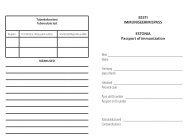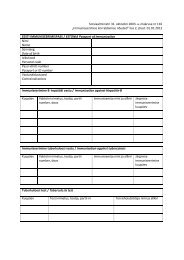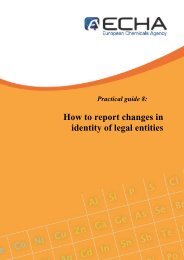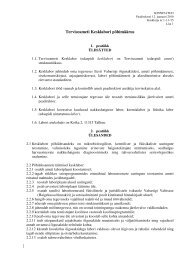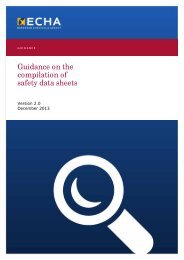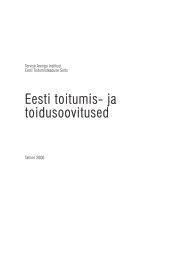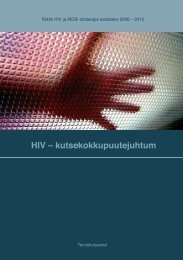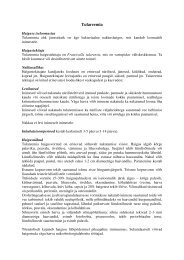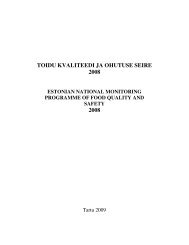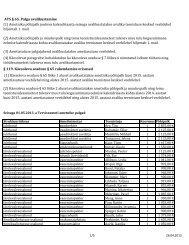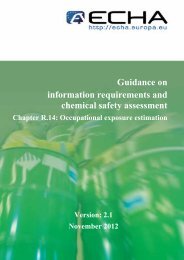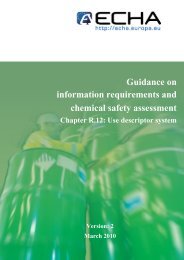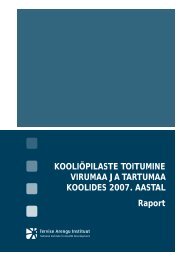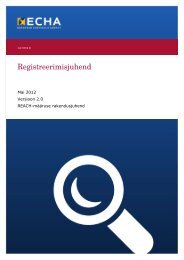Guidance for monomers and polymers - ECHA - Europa
Guidance for monomers and polymers - ECHA - Europa
Guidance for monomers and polymers - ECHA - Europa
You also want an ePaper? Increase the reach of your titles
YUMPU automatically turns print PDFs into web optimized ePapers that Google loves.
GUIDANCE<br />
<strong>Guidance</strong> <strong>for</strong> <strong>monomers</strong><br />
<strong>and</strong> <strong>polymers</strong><br />
April 2012<br />
Version 2.0<br />
<strong>Guidance</strong> <strong>for</strong> the implementation of REACH<br />
Annankatu 18, P.O. Box 400, FI-00121 Helsinki, Finl<strong>and</strong> | Tel. +358 9 686180 | Fax +358 9 68618210 | echa.europa.eu
2<br />
<strong>Guidance</strong> <strong>for</strong> <strong>monomers</strong> <strong>and</strong> <strong>polymers</strong><br />
Version 2.0 April 2012<br />
Version Changes Date<br />
Version 0 First edition June 2007<br />
Version 1<br />
Version 1.1<br />
Version 2.0<br />
Section 2.2 - More explanations given on the<br />
definition of polymer (including different types of<br />
additives). Most of section 3.3 transferred to<br />
here.<br />
Section 3.1 - Clarification of cases where the<br />
substance is used both as monomer <strong>and</strong> as<br />
intermediate under strictly controlled conditions.<br />
Section 3.2.1.1 - Addition of a sentence to<br />
clarify that there is no need to register<br />
stabilisers<br />
Section 3.2.1.2 - The section has been modified<br />
in order to reflect a proposal <strong>for</strong> solution <strong>for</strong><br />
those substances already notified.<br />
Section 3.2.1.3 - Some wording change <strong>for</strong><br />
clarification that only the substance used <strong>for</strong> the<br />
modification of the natural polymer needs to be<br />
registered when ending up chemically bound to<br />
the polymer.<br />
Section 3.2.1.4 - Need <strong>for</strong> update<br />
acknowledged.<br />
Previous Section 3.3 - Deleted <strong>and</strong> mostly<br />
transferred to section 2.2.<br />
Section 3.2.1.2 - Based on the comments<br />
received from Irel<strong>and</strong> after the CA meeting in<br />
December 2007 some additional guidance on<br />
what needs to be done <strong>for</strong> notified <strong>polymers</strong> has<br />
been added (4 pages).<br />
Section 2.1 <strong>and</strong> 3.1 – Reference to <strong>monomers</strong> as<br />
intermediate reworded in order to be consistent with<br />
new clarification of intermediate definition.<br />
Section 2.2 - Clarification of the definition of<br />
“unreacted <strong>monomers</strong>” which remains in the<br />
polymer’s composition.<br />
Section 3.2.1 – Clarification of registration obligations<br />
in regard to unreacted <strong>monomers</strong> according to article<br />
6(1). The reference to Art.6(1) has been added<br />
throughout the document.<br />
Section 3.2.1.1, 3.2.1.2 <strong>and</strong> 3.2.1.4 – Addition of the<br />
reference to late pre-registration possibility.<br />
Section 3.2.1.3 – Amendment of the case of naturally<br />
occurring polymer to be consistent with the new<br />
agreed interpretation.<br />
18/03/2008<br />
27/05/2008<br />
April 2012<br />
Annankatu 18, P.O. Box 400, FI-00121 Helsinki, Finl<strong>and</strong> | Tel. +358 9 686180 | Fax +358 9 68618210 | echa.europa.eu
<strong>Guidance</strong> <strong>for</strong> <strong>monomers</strong> <strong>and</strong> <strong>polymers</strong><br />
Version 2.0 April 2012 3<br />
Section 3.2.4 – Amendment of the section on<br />
classification <strong>and</strong> labelling to bring it in line with the<br />
CLP regulation <strong>and</strong> its requirements.<br />
Example 4 – Table indicating the quantities of<br />
substances ending up in the <strong>polymers</strong> amended.<br />
Section 4.2.2 – Implementation of the reading of the<br />
Court Case C-558/07 <strong>and</strong> clarification on the<br />
calculation of the tonnage <strong>for</strong> registration purposes.<br />
Example 5 – Amendment following implementation of<br />
the Court Case reading in the core text.<br />
Annankatu 18, P.O. Box 400, FI-00121 Helsinki, Finl<strong>and</strong> | Tel. +358 9 686180 | Fax +358 9 68618210 | echa.europa.eu
4<br />
<strong>Guidance</strong> <strong>for</strong> <strong>monomers</strong> <strong>and</strong> <strong>polymers</strong><br />
Version 2.0 April 2012<br />
LEGAL NOTICE<br />
This document contains guidance on REACH explaining the REACH obligations <strong>and</strong> how to fulfil<br />
them. However, users are reminded that the text of the EACH Regulation is the only authentic<br />
legal reference <strong>and</strong> that the in<strong>for</strong>mation in this document does not constitute legal advice. The<br />
European Chemicals Agency does not accept any liability with regard to the contents of this<br />
document.<br />
<strong>Guidance</strong> <strong>for</strong> <strong>monomers</strong> <strong>and</strong> <strong>polymers</strong><br />
Reference: <strong>ECHA</strong>-12-G-02-EN<br />
Publ.date: April 2012<br />
Language: EN<br />
© European Chemicals Agency, 2012<br />
Cover page © European Chemicals Agency<br />
This document contains guidance on REACH explaining the REACH obligations <strong>and</strong> how to fulfil<br />
them. However, users are reminded that the text of the REACH regulation is the only authentic<br />
legal reference <strong>and</strong> that the in<strong>for</strong>mation in this document does not constitute legal advice. The<br />
European Chemicals Agency does not accept any liability with regard to the contents of this<br />
document.<br />
Reproduction is authorised provided the source is fully acknowledged in the <strong>for</strong>m<br />
“Source: European Chemicals Agency, http://echa.europa.eu/”, <strong>and</strong> provided written<br />
notification is given to the <strong>ECHA</strong> Communication Unit (publications@echa.europa.eu).<br />
If you have questions or comments in relation to this document please send them (indicating<br />
the document reference, issue date, chapter <strong>and</strong>/or page of the document to which your<br />
comment refers) using the <strong>Guidance</strong> feedback <strong>for</strong>m. The feedback <strong>for</strong>m can be accessed via<br />
the <strong>ECHA</strong> <strong>Guidance</strong> website or directly via the following link:<br />
https://comments.echa.europa.eu/comments_cms/Feedback<strong>Guidance</strong>.aspx<br />
European Chemicals Agency<br />
Mailing address: P.O. Box 400, FI-00121 Helsinki, Finl<strong>and</strong><br />
Visiting address: Annankatu 18 Helsinki, Finl<strong>and</strong><br />
Annankatu 18, P.O. Box 400, FI-00121 Helsinki, Finl<strong>and</strong> | Tel. +358 9 686180 | Fax +358 9 68618210 | echa.europa.eu
<strong>Guidance</strong> <strong>for</strong> <strong>monomers</strong> <strong>and</strong> <strong>polymers</strong><br />
Version 2.0 April 2012 5<br />
PREFACE<br />
This document describes the specific provisions <strong>for</strong> <strong>polymers</strong> <strong>and</strong> <strong>monomers</strong> under REACH. It<br />
is part of a series of guidance documents that aims to help all stakeholders with their<br />
preparation <strong>for</strong> fulfilling their obligations under the REACH regulation. These documents give<br />
detailed guidance <strong>for</strong> a range of essential REACH processes as well as <strong>for</strong> some specific<br />
scientific <strong>and</strong>/or technical methods that industry or authorities need to make use of under<br />
REACH.<br />
The guidance documents have been drafted <strong>and</strong> discussed within the REACH Implementation<br />
Projects (RIPs) led by the European Commission services, involving stakeholders from Member<br />
States, industry <strong>and</strong> non-governmental organisations. The European Chemicals Agency (<strong>ECHA</strong>)<br />
updates these guidance documents following the Consultation procedure on guidance. These<br />
guidance documents can be obtained via the website of the European Chemicals Agency<br />
(http://echa.europa.eu/web/guest/guidance-documents/guidance-on-reach). Further guidance<br />
documents will be published on this website when they are finalised or updated.<br />
This document relates to the REACH Regulation (EC) No 1907/2006 of the European<br />
Parliament <strong>and</strong> of the Council of 18 December 2006 1<br />
1 Corrigendum to Regulation (EC) No 1907/2006 of the European Parliament <strong>and</strong> of the Council of 18 December 2006<br />
concerning the Registration, Evaluation, Authorisation <strong>and</strong> Restriction of Chemicals (REACH), establishing a European<br />
Chemicals Agency, amending Directive 1999/45/EC <strong>and</strong> repealing Council Regulation (EEC) No 793/93 <strong>and</strong> Commission<br />
Regulation (EC) No 1488/94 as well as Council Directive 76/769/EEC <strong>and</strong> Commission Directives 91/155/EEC,<br />
93/67/EEC, 93/105/EC <strong>and</strong> 2000/21/EC (OJ L 396, 30.12.2006); amended by Council Regulation (EC) No 1354/2007 of<br />
15 November 2007 adapting Regulation (EC) No 1907/2006 of the European Parliament <strong>and</strong> of the Council on the<br />
Registration, Evaluation, Authorisation <strong>and</strong> Restriction of Chemicals (REACH) by reason of the accession of Bulgaria <strong>and</strong><br />
Romania (OJ L 304, 22.11.2007, p. 1).<br />
Annankatu 18, P.O. Box 400, FI-00121 Helsinki, Finl<strong>and</strong> | Tel. +358 9 686180 | Fax +358 9 68618210 | echa.europa.eu
6<br />
<strong>Guidance</strong> <strong>for</strong> <strong>monomers</strong> <strong>and</strong> <strong>polymers</strong><br />
Version 2.0 April 2012<br />
Table of Contents<br />
1. INTRODUCTION................................................................................................ 8<br />
2. Definitions ........................................................................................................ 8<br />
2.1 Monomer ...................................................................................................................... 8<br />
2.2 Polymer........................................................................................................................ 9<br />
2.3 Manufacture of polymer .................................................................................................. 11<br />
3. Tasks <strong>and</strong> obligations ....................................................................................... 13<br />
3.1 Manufacture/import of <strong>monomers</strong>..................................................................................... 13<br />
3.2 Manufacture/import of <strong>polymers</strong>....................................................................................... 14<br />
3.2.1 Registration obligation ................................................................................................. 14<br />
3.2.1.1 General situation ..........................................................................................................................14<br />
3.2.1.2 Case of a polymer notified in accordance with Directive 67/548/EEC ...................................................16<br />
3.2.1.3 Case of a natural polymer or a chemically modified natural polymer ...................................................20<br />
3.2.1.4 Case of a recycled polymer ............................................................................................................20<br />
3.2.2 Application <strong>for</strong> authorisation ......................................................................................... 21<br />
3.2.3 Compliance with restrictions ......................................................................................... 21<br />
3.2.4 Classification <strong>and</strong> labelling ............................................................................................ 21<br />
3.2.5 In<strong>for</strong>mation down the supply chain ................................................................................ 22<br />
3.3 Production/import of articles containing polymer substances ................................................ 23<br />
4. Analytical methods ........................................................................................... 24<br />
4.1 Identification of polymer substances ................................................................................. 24<br />
4.2 Monomer/other reactant content in the polymer ................................................................. 24<br />
4.2.1 Monomer/other reactant concentration ........................................................................... 24<br />
4.2.2 Monomer/other reactant tonnage to be considered <strong>for</strong> registration purposes ........................ 24<br />
Annankatu 18, P.O. Box 400, FI-00121 Helsinki, Finl<strong>and</strong> | Tel. +358 9 686180 | Fax +358 9 68618210 | echa.europa.eu
<strong>Guidance</strong> <strong>for</strong> <strong>monomers</strong> <strong>and</strong> <strong>polymers</strong><br />
Version 2.0 April 2012 7<br />
Table of Examples<br />
Example 1 Monomer definition: the propylene case .................................................................. 9<br />
Example 2 : Example illustrating the definitions of section 2 ...................................................... 11<br />
Example 3 Registration obligations of the different actors of the monomer <strong>and</strong> polymer supply chains<br />
........................................................................................................................................ 15<br />
Example 4 : Example on the identification of the monomer substances <strong>and</strong> other substances to be<br />
registered by an importer of polymer ..................................................................................... 22<br />
Example 5 : Illustration <strong>for</strong> the calculation of the monomer unit concentration <strong>and</strong> tonnage of monomer<br />
ending up in the final polymer as reacted or unreacted substance............................................... 25<br />
Table of Figures<br />
Figure 1: Propylene polymerisation ........................................................................................ 9<br />
Figure 2: Propylene epoxidation reaction................................................................................. 9<br />
Figure 3: ethoxylated phenol (n is an integer, n≥1).................................................................. 11<br />
Figure 4: One representation of the general structure of the reaction product from glycerol, ethylene<br />
oxide <strong>and</strong> propylene oxide (x, y <strong>and</strong> z are integers, R1, R2 <strong>and</strong> R3 are H atoms or methyl groups)..22<br />
Annankatu 18, P.O. Box 400, FI-00121 Helsinki, Finl<strong>and</strong> | Tel. +358 9 686180 | Fax +358 9 68618210 | echa.europa.eu
8<br />
<strong>Guidance</strong> <strong>for</strong> <strong>monomers</strong> <strong>and</strong> <strong>polymers</strong><br />
Version 2.0 April 2012<br />
1. INTRODUCTION<br />
Polymers are the material of choice in a vast range of applications such as packaging, building<br />
<strong>and</strong> construction, transportation, electrical <strong>and</strong> electronic equipment, agriculture, as well as in<br />
the medical <strong>and</strong> the sports sectors. The versatility of polymeric materials is due to the fact that<br />
the physico-chemical properties of <strong>polymers</strong> can be tailored by a careful adjustment of the<br />
composition <strong>and</strong> molecular weight distribution of the molecules constituting the polymer.<br />
Owing to the potentially extensive number of different polymer substances on the market, <strong>and</strong><br />
since polymer molecules are generally regarded as representing a low concern due to their<br />
high molecular weight, this group of substances is exempted from registration <strong>and</strong> evaluation<br />
under REACH. Polymers may however still be subject to authorisation <strong>and</strong> restriction.<br />
Nonetheless, manufacturers <strong>and</strong> importers of <strong>polymers</strong> may still be required to register the<br />
<strong>monomers</strong> or other substances used as building blocks of the polymer, as these molecules are<br />
generally recognised as of higher concern than the polymer molecule itself.<br />
2. Definitions<br />
2.1 Monomer<br />
REACH defines a monomer as a substance which is capable of <strong>for</strong>ming covalent bonds with a<br />
sequence of additional like or unlike molecules under the conditions of the relevant polymer<strong>for</strong>ming<br />
reaction used <strong>for</strong> the particular process (Article 3(6)). In other words, it is a substance<br />
which, via the polymerisation reaction, is converted into a repeating unit of the polymer<br />
sequence. Substances exclusively involved in the catalysis, initiation or termination of the<br />
polymer reaction are not <strong>monomers</strong>. Any substance used as a monomer in the manufacturing<br />
of a polymer is there<strong>for</strong>e by definition an intermediate. Nonetheless, the specific provisions <strong>for</strong><br />
the registration of intermediates under REACH do not apply to <strong>monomers</strong>.<br />
For applications outside the scope of polymerisation, the same substance is not regarded as a<br />
monomer. If it is used as an intermediate, it may fulfil the conditions to benefit from the<br />
specific provisions <strong>for</strong> the registration of intermediates under REACH (see the <strong>Guidance</strong> <strong>for</strong><br />
intermediates 2 ). Otherwise, it will have to comply with all REACH requirements <strong>for</strong> a “normal<br />
substance” including registration requirements in accordance with Title II (see the <strong>Guidance</strong> on<br />
registration).<br />
2 All the <strong>ECHA</strong> <strong>Guidance</strong> Documents are available on the <strong>ECHA</strong> <strong>Guidance</strong> web page, in “support” section at:<br />
http://echa.europa.eu/web/guest/guidance-documents/guidance-on-reach.<br />
Annankatu 18, P.O. Box 400, FI-00121 Helsinki, Finl<strong>and</strong> | Tel. +358 9 686180 | Fax +358 9 68618210 | echa.europa.eu
<strong>Guidance</strong> <strong>for</strong> <strong>monomers</strong> <strong>and</strong> <strong>polymers</strong><br />
Version 2.0 April 2012 9<br />
An illustration of the definition of monomer is provided in Example 1.<br />
Example 1 Monomer definition: the propylene case<br />
Propylene is to be considered as a monomer under REACH when it is used <strong>for</strong> the purpose of<br />
polymerisation process such as polypropylene manufacture, as illustrated in Figure 1:<br />
Figure 1: Propylene polymerisation<br />
Propylene Polypropylene<br />
*<br />
n<br />
*<br />
Propylene may also be used <strong>for</strong> the manufacture of propylene oxide, <strong>for</strong> instance according to<br />
a catalytic epoxidation reaction with hydrogen peroxide. The reaction is illustrated in Figure 2.<br />
For this application, propylene is in fact an intermediate but is not regarded as a monomer.<br />
Figure 2: Propylene epoxidation reaction<br />
H 2<br />
O 2<br />
O<br />
catalyst<br />
propylene<br />
propylene oxide<br />
Another example of the application of propylene is in its utilisation as fuel gas in certain<br />
industrial processes. In this specific case, propylene is regarded as neither an intermediate nor<br />
a monomer.<br />
2.2 Polymer<br />
A polymer is a substance consisting of molecules characterised by the sequence of one or more<br />
types of monomer unit. Such molecules must be distributed over a range of molecular weights.<br />
Differences in the molecular weight are primarily attributable to differences in the number of<br />
monomer units.<br />
In accordance with REACH (Article 3(5)), a polymer is defined as a substance meeting the<br />
following criteria:<br />
(a)<br />
(b)<br />
Over 50 percent of the weight <strong>for</strong> that substance consists of polymer molecules (see<br />
definition below); <strong>and</strong>,<br />
The amount of polymer molecules presenting the same molecular weight must be less<br />
than 50 weight percent of the substance.<br />
In the context of this definition:<br />
<br />
A "polymer molecule" is a molecule that contains a sequence of at least 3 monomer<br />
units, which are covalently bound to at least one other monomer unit or other<br />
reactant.<br />
Annankatu 18, P.O. Box 400, FI-00121 Helsinki, Finl<strong>and</strong> | Tel. +358 9 686180 | Fax +358 9 68618210 | echa.europa.eu
10<br />
<strong>Guidance</strong> <strong>for</strong> <strong>monomers</strong> <strong>and</strong> <strong>polymers</strong><br />
Version 2.0 April 2012<br />
<br />
<br />
<br />
A "monomer unit" means the reacted <strong>for</strong>m of a monomer substance in a polymer (<strong>for</strong><br />
the identification of the monomeric unit(s) in the chemical structure of the polymer the<br />
mechanism of polymer <strong>for</strong>mation may, <strong>for</strong> instance, be taken into consideration).<br />
A "sequence" is a continuous string of monomer units within the molecule that are<br />
covalently bonded to one another <strong>and</strong> are uninterrupted by units other than monomer<br />
units. This continuous string of monomer units can possibly follow any network within<br />
the polymer structure.<br />
"Other reactant" refers to a molecule that can be linked to one or more sequences of<br />
monomer units but which cannot be regarded as a monomer under the relevant<br />
reaction conditions used <strong>for</strong> the polymer <strong>for</strong>mation process.<br />
These definitions are exemplified in Example 2.<br />
A polymer, as any other substance defined in Article 3(1), can also contain additives<br />
necessary to preserve the stability of the polymer <strong>and</strong> impurities deriving from the<br />
manufacturing process. These stabilisers <strong>and</strong> impurities are considered to be part of the<br />
substance <strong>and</strong> do not have to be registered separately. Stabilisers include, <strong>for</strong> example, heat<br />
stabilisers, anti-oxidants (both useful during extrusion) <strong>and</strong> light stabilisers (e.g. <strong>for</strong><br />
preservation during use). Impurities are unintended constituents of the polymer such as<br />
catalysts residues. The quantities of a monomer substance which do not react during the<br />
polymerisation reaction <strong>and</strong> remain in the composition of a polymer are referred to as<br />
“unreacted <strong>monomers</strong>”. Unreacted <strong>monomers</strong> in a polymer are also constituents of that<br />
polymer. Registration obligations linked to the presence of these unreacted <strong>for</strong>ms are<br />
explained in sections 3.2.1 <strong>and</strong> 4.2.2 3 .<br />
Substances may also be added to improve the per<strong>for</strong>mance of the polymer even though they<br />
are not necessary <strong>for</strong> preserving the stability of the polymer. Indeed, substances are<br />
commonly added to a polymer <strong>for</strong> the purpose of adjusting or improving the appearance<br />
<strong>and</strong>/or the physico-chemical properties of the polymeric material. Examples of such substances<br />
include pigments, lubricants, thickeners, antistatic agents, antifogging agents, nucleating<br />
agents <strong>and</strong> flame retardants. When a polymeric material contains such substances it should be<br />
considered as a mixture or an article, as the case may be (see section 3.3). For such<br />
substances normal registration requirements apply (see the <strong>Guidance</strong> on registration)<br />
Under REACH <strong>and</strong> in the guidance documents developed by the Commission <strong>and</strong> <strong>ECHA</strong>, only<br />
stabilising agents are considered as additives. Substances added to <strong>polymers</strong> to provide any<br />
function other than stabilisation are commonly called “polymer additives”. However, <strong>for</strong> the<br />
purpose of this guidance, these substances are not referred to as additives.<br />
When a given substance can be used both <strong>for</strong> preserving the stability of the polymer <strong>and</strong> <strong>for</strong><br />
improving its per<strong>for</strong>mance (e.g. if the substance acts as a light stabiliser <strong>and</strong> a flame<br />
retardant), it is good practice to consider only the quantities necessary to preserve the stability<br />
of the polymer substance. The quantity of the substance that is not necessary to preserve the<br />
stability of the polymer cannot be regarded a part of the polymeric substance. It should be<br />
considered as another substance within a mixture. As such it may need to be registered.<br />
3 The approach suggested with regard to reacted <strong>and</strong> unreacted <strong>monomers</strong> <strong>and</strong> other substances follows the judgement<br />
of the European Court of Justice in EU Case C-558/07 of 07 July 2009 available at http://eurlex.europa.eu/LexUriServ/LexUriServ.do?uri=CELEX:62007CJ0558:EN:HTML.<br />
See in particular paragraphs 20,<br />
38 <strong>and</strong> 51 of the judgment.<br />
Annankatu 18, P.O. Box 400, FI-00121 Helsinki, Finl<strong>and</strong> | Tel. +358 9 686180 | Fax +358 9 68618210 | echa.europa.eu
<strong>Guidance</strong> <strong>for</strong> <strong>monomers</strong> <strong>and</strong> <strong>polymers</strong><br />
Version 2.0 April 2012 11<br />
Whenever it is not scientifically possible to establish either of the following:<br />
i) whether the substance falls under the definition of polymer<br />
ii)<br />
the chemical structure of the monomer units (or any other unit) as well as their<br />
concentration in the substance<br />
the substance can be regarded as a UVCB substance. A UVCB substance is a substance of<br />
Unknown or Variable composition, Complex reaction products or Biological material (see<br />
<strong>Guidance</strong> <strong>for</strong> identification <strong>and</strong> naming of substance under REACH. In this case the registration<br />
<strong>for</strong> the substance itself can be submitted (see the <strong>Guidance</strong> on registration).<br />
2.3 Manufacture of polymer<br />
Any legal or natural person established within the Community, who manufactures a polymer<br />
substance, or isolates a polymer substance in its natural state, is a polymer manufacturer<br />
(Article 3(8) <strong>and</strong> 3(9)).<br />
It should be highlighted that <strong>polymers</strong> may be synthesised not only from the polymerisation of<br />
<strong>monomers</strong>, but also from other processes such as the chemical post-modification of polymer<br />
substances. Examples of such post-modification reactions include polymer curing, polymer<br />
functionalisation via grafting, <strong>and</strong> controlled polymer degradation such as visbreaking (thermal<br />
cracking).<br />
Example 2: Example illustrating the definitions of section 2<br />
To illustrate the definitions given in Section 2.1 <strong>and</strong> 2.2, let us consider a polymer <strong>for</strong>ming<br />
reaction taking place when ethylene oxide is reacted with phenol.<br />
Figure 3 represents the molecule likely to be <strong>for</strong>med upon completion of this ethoxylationtype<br />
of polymerisation reaction.<br />
O<br />
O<br />
n<br />
H<br />
Figure 3: ethoxylated phenol (n is an integer, n≥1)<br />
The monomer unit is in this case the opened epoxide -(CH2-CH2-O)-<br />
Phenol acts as the initiator of the ethoxylation reaction, <strong>and</strong> must be regarded as an "other<br />
reactant" since it cannot react with either itself or an opened epoxide.<br />
The molecule depicted in<br />
Figure 3 would there<strong>for</strong>e qualify <strong>for</strong> the definition of "polymer molecule" whenever n≥3.<br />
The ethoxylated phenol substance thus manufactured must be regarded as a polymer if both<br />
following conditions are met:<br />
(a) Over 50 weight percent of the substance consists of polymer molecules, i.e. molecules<br />
depicted in<br />
Figure 3 <strong>and</strong> <strong>for</strong> which n≥3)<br />
(b) None of the polymer molecules having the same molecular weight represent 50 weight<br />
Annankatu 18, P.O. Box 400, FI-00121 Helsinki, Finl<strong>and</strong> | Tel. +358 9 686180 | Fax +358 9 68618210 | echa.europa.eu
12<br />
<strong>Guidance</strong> <strong>for</strong> <strong>monomers</strong> <strong>and</strong> <strong>polymers</strong><br />
Version 2.0 April 2012<br />
percent or more of the substance.<br />
In Table 1 three different compositions of the ethoxylated phenol substance are considered.<br />
For each example, the weight percent of every molecule present in the substance is reported.<br />
Table 1 Molecular composition of 3 examples of ethoxylated phenol substances.<br />
O<br />
O<br />
n<br />
H<br />
Example 1 Example 2 Example 3<br />
n=1 0% 40% 5%<br />
n=2 10% 20% 10%<br />
n=3 85% 15% 20%<br />
n=4 5% 12% 30%<br />
n=5 0% 8% 20%<br />
n=6 0% 5% 10%<br />
n=7 0% 0% 5%<br />
Sum 100% 100% 100%<br />
In Example 1, the substance consists of 10% ethoxylated phenol with n=2, 85% with n=3 <strong>and</strong><br />
5% with n=4. Since this substance comprises 85 weight percent of the same polymer molecule<br />
(n=3), it does not meet the definition of a polymer. There<strong>for</strong>e, it should be considered as a<br />
st<strong>and</strong>ard substance.<br />
In Example 2, only 15+12+8+5=40 weight percent of the substance consists of polymer<br />
molecules, i.e. molecules <strong>for</strong> which n3. For this reason, example 2 does not comply with the<br />
criteria <strong>for</strong> polymer definition either. There<strong>for</strong>e it should also be considered as a st<strong>and</strong>ard<br />
substance.<br />
Example 3 meets the definition of a polymer since 20+30+20+10+5=85 weight percent of the<br />
substance consists of polymer molecules (i.e. molecules <strong>for</strong> which n3) <strong>and</strong> none of the<br />
different constituents are present at concentrations above 50 weight percent (each constituent<br />
having a different molecular weight).<br />
Annankatu 18, P.O. Box 400, FI-00121 Helsinki, Finl<strong>and</strong> | Tel. +358 9 686180 | Fax +358 9 68618210 | echa.europa.eu
<strong>Guidance</strong> <strong>for</strong> <strong>monomers</strong> <strong>and</strong> <strong>polymers</strong><br />
Version 2.0 April 2012 13<br />
3. Tasks <strong>and</strong> obligations<br />
3.1 Manufacture/import of <strong>monomers</strong><br />
Manufacturers or importers of <strong>monomers</strong> have to register their <strong>monomers</strong> in accordance with<br />
the normal registration obligation laid down in Article 6 of REACH. Although substances used<br />
as <strong>monomers</strong> in the manufacturing of <strong>polymers</strong> are by definition intermediates, these<br />
substances cannot be registered in accordance with the provisions which normally apply to onsite<br />
or transported isolated intermediates (Article 6(2)). However, Articles 17 <strong>and</strong> 18 (on<br />
intermediates) do apply <strong>for</strong> the other substances to be trans<strong>for</strong>med into the manufactured<br />
polymer, provided those other substances meet the conditions specified in Articles 17 <strong>and</strong> 18<br />
(see the <strong>Guidance</strong> <strong>for</strong> intermediates).<br />
If a natural or legal person manufactures or imports a substance to be used both as a<br />
monomer <strong>and</strong> as a non-monomeric intermediate, a “st<strong>and</strong>ard” registration dossier, in<br />
accordance with Article 10, is required to be submitted. In this situation, where part of the<br />
tonnage is manufactured <strong>and</strong> used as a non-monomeric intermediate under strictly controlled<br />
conditions, the registrant can still submit one registration dossier covering the total tonnage.<br />
The in<strong>for</strong>mation requirements <strong>for</strong> this registration dossier are based on the tonnage <strong>for</strong> non<br />
intermediate uses (including <strong>monomers</strong> used <strong>for</strong> polymerisation) <strong>and</strong> <strong>for</strong> intermediates not<br />
used under strictly controlled conditions. The part of the tonnage manufactured or imported <strong>for</strong><br />
use as non-monomeric intermediate under strictly controlled conditions will not need to be<br />
taken into account <strong>for</strong> the in<strong>for</strong>mation requirements of the registration dossier. Nevertheless,<br />
the use as an intermediate including the volume manufactured or imported <strong>for</strong> this purpose<br />
should be documented in the dossier. For instance, if a manufacturer manufactures 11<br />
tonnes/year of a substance, of which 2 tonnes/year are <strong>for</strong> use as monomer <strong>and</strong> the remaining<br />
9 tonnes/year is <strong>for</strong> use as a non-monomeric intermediate h<strong>and</strong>led under strictly controlled<br />
conditions, the registration in<strong>for</strong>mation requirements <strong>for</strong> that substance will be based on the 2<br />
tonnes/year. In addition, the 9 tonnes/year to be registered according to Article 17 or 18<br />
should be documented in the registration dossier. The fees will be calculated independently <strong>for</strong><br />
the use as an intermediate under strictly controlled conditions (fees <strong>for</strong> intermediates) <strong>and</strong> <strong>for</strong><br />
the other uses (st<strong>and</strong>ard fees).<br />
Substances used as <strong>monomers</strong> in the manufacturing of <strong>polymers</strong> are by definition<br />
intermediates. There<strong>for</strong>e, they cannot be subject to authorisation under REACH <strong>for</strong> such use.<br />
The manufacturer or importer of a monomer substance has otherwise the same obligations<br />
under REACH as <strong>for</strong> any st<strong>and</strong>ard substance: general rules on restriction, in<strong>for</strong>mation down the<br />
supply chain <strong>and</strong> classification <strong>and</strong> labelling there<strong>for</strong>e apply.<br />
Annankatu 18, P.O. Box 400, FI-00121 Helsinki, Finl<strong>and</strong> | Tel. +358 9 686180 | Fax +358 9 68618210 | echa.europa.eu
14<br />
<strong>Guidance</strong> <strong>for</strong> <strong>monomers</strong> <strong>and</strong> <strong>polymers</strong><br />
Version 2.0 April 2012<br />
3.2 Manufacture/import of <strong>polymers</strong><br />
3.2.1 Registration obligation<br />
3.2.1.1 General situation<br />
Polymers are exempted from the provisions on registration of Title II of REACH (Article 2(9)).<br />
The manufacturer or importer of a polymer is there<strong>for</strong>e generally not required to provide to the<br />
Agency any in<strong>for</strong>mation related to the intrinsic properties of the polymer itself, with the<br />
exception of its classification <strong>and</strong> labelling when applicable (see Section 3.2.4).<br />
According to Article 6(3), the manufacturer or importer of a polymer must however submit a<br />
registration to the Agency <strong>for</strong> the monomer substance(s) or any other substance(s) that have<br />
not already been registered by an actor up the supply chain, if both the following conditions<br />
are met:<br />
(a)<br />
(b)<br />
the polymer consists of 2% weight by weight (w/w) or more of such monomer<br />
substance(s) or other substance(s) in the <strong>for</strong>m of monomeric units <strong>and</strong> chemically bound<br />
substance(s);<br />
the total quantity of such monomer substance(s) or other substance(s) makes up 1 tonne<br />
or more per year (the total quantity in this context is the total quantity of monomer or<br />
other substance ending up chemically bound to the polymer).<br />
Furthermore, where the polymer includes, in its composition, unreacted monomer (or residues<br />
from any other substance within the meaning of Article 6(3)), the quantity of that monomer<br />
(or any other substance) also needs to be registered according to Article 6(1) 4 . This does not<br />
mean that an additional registration <strong>for</strong> the unreacted monomer is necessary. Both the reacted<br />
<strong>monomers</strong> <strong>and</strong> unreacted monomer should be covered in the same registration dossier <strong>for</strong> that<br />
monomer substance. This applies also to other substances within the meaning of Article 6(3).<br />
In practice, the manufacturer or importer of a polymer will not need to register the monomer<br />
substance, or any other substance chemically bound to the polymer, if these have already<br />
been registered by the supplier or another actor up their supply chain. For most polymer<br />
manufacturers the situation will generally be that their <strong>monomers</strong> <strong>and</strong> other substances will be<br />
registered by the suppliers of these substances. However, <strong>for</strong> an importer of a polymer<br />
consisting of monomer(s) or other substance(s) fulfilling both the conditions (a) <strong>and</strong> (b) stated<br />
above, the monomer(s) or other substance(s) must be registered unless:<br />
an only representative has been appointed by the non-Community polymer<br />
manufacturer to fulfil the obligations of the importer. In this specific case, it is the duty<br />
of the only representative to proceed with the registration of the monomer(s) (Article<br />
8), or<br />
4 For further in<strong>for</strong>mation, please refer to the judgment of the European Court of Justice in EU Case C-558/07 of 07 July<br />
2009 available at http://eur-lex.europa.eu/LexUriServ/LexUriServ.do?uri=CELEX:62007CJ0558:EN:HTML.<br />
See in particular paragraphs 20, 38 <strong>and</strong> 51 of the judgment.<br />
Annankatu 18, P.O. Box 400, FI-00121 Helsinki, Finl<strong>and</strong> | Tel. +358 9 686180 | Fax +358 9 68618210 | echa.europa.eu
<strong>Guidance</strong> <strong>for</strong> <strong>monomers</strong> <strong>and</strong> <strong>polymers</strong><br />
Version 2.0 April 2012 15<br />
<br />
the monomer substances or any other substances used <strong>for</strong> the manufacture of the<br />
polymer have already been registered up the supply chain, e.g. if they have been<br />
manufactured within the Community <strong>and</strong> exported to a non-Community polymer<br />
manufacturer.<br />
Importers of <strong>polymers</strong> do not need to register the quantity of additives necessary to preserve<br />
the stability of the polymer as they are part of the polymer (see section 2.2).<br />
The registration requirements <strong>for</strong> the different actors in the supply chain are illustrated in<br />
Example 3.<br />
Example 3 Registration obligations of the different actors of the monomer <strong>and</strong><br />
polymer supply chains<br />
EU border<br />
OUTSIDE EU<br />
EU<br />
Registration<br />
obligations<br />
Non-EU<br />
Manufacturer 3<br />
Polymer -(A-<br />
B) n-<br />
Importer 5<br />
Importer 5<br />
registers Monomer A<br />
(unless the non-EU manufacturer<br />
3 has appointed an only<br />
representative to fulfil the<br />
obligations of Importer 5)<br />
Non-EU<br />
Manufacturer 1<br />
Monomer A<br />
Monomer B<br />
Manufacturer 2<br />
Manufacturer 2<br />
registers Monomer B<br />
Polymer -(A-<br />
B) n-<br />
Manufacturer 4<br />
Manufacturer 4<br />
No need to register<br />
Importer 6<br />
Importer 6<br />
registers monomer A<br />
(unless the non-EU<br />
manufacturer 1 has appointed an<br />
only representative to fulfil the<br />
obligations of Importer 6)<br />
Annankatu 18, P.O. Box 400, FI-00121 Helsinki, Finl<strong>and</strong> | Tel. +358 9 686180 | Fax +358 9 68618210 | echa.europa.eu
16<br />
<strong>Guidance</strong> <strong>for</strong> <strong>monomers</strong> <strong>and</strong> <strong>polymers</strong><br />
Version 2.0 April 2012<br />
In order to establish their obligations under REACH, <strong>and</strong> to avoid the need <strong>for</strong> carrying out any<br />
complex chemical analysis on the polymer composition, the importer of a polymer should<br />
preferably obtain from the non-Community polymer manufacturer at least the in<strong>for</strong>mation on<br />
the identity of <strong>monomers</strong> <strong>and</strong> any other substance chemically bound to the polymer, as well as<br />
compositional details of the polymer substance. Alternatively, this in<strong>for</strong>mation may also be<br />
generated from the analytical methods specified in section 4.<br />
Registration of the <strong>monomers</strong> <strong>and</strong> of the substances described above has to be prepared as <strong>for</strong><br />
any other substances. Further guidance on this can be found in the <strong>Guidance</strong> on registration.<br />
Example 4 (section 3.2.5) illustrates the considerations to be taken into account by the<br />
polymer importer <strong>for</strong> the purpose of registration of the <strong>monomers</strong> or other substances.<br />
Note that all the <strong>monomers</strong> <strong>and</strong> other substances which need to be registered can benefit from<br />
the extended deadlines <strong>for</strong> registration only if they have been pre-registered between the<br />
1 st June 2008 <strong>and</strong> the 1 st December 2008 or in accordance with the conditions set out<br />
in Article 28(6) 5 .<br />
3.2.1.2 Case of a polymer notified in accordance with Directive 67/548/EEC 6<br />
Polymer substances notified in accordance with Directive 67/548/EEC are regarded as<br />
registered by the manufacturer or importer who submitted the notification (Article 24(1)). The<br />
registration requirements under Title II are there<strong>for</strong>e covered by the notification <strong>for</strong> the<br />
tonnage b<strong>and</strong> <strong>for</strong> which the notification was made. Registration of the <strong>monomers</strong> or other<br />
substances from which the notified <strong>polymers</strong> are derived is not required 7 . As soon as the<br />
manufactured/imported quantity of polymer reaches the next tonnage threshold, the<br />
registration requirements (Title II of REACH) as described in this guidance should be followed<br />
<strong>for</strong> the monomer(s) or any other substance(s) meeting the provisions of Articles 6(1) <strong>and</strong> 6(3).<br />
By doing so, the registrant will update his registration dossier, according to Article 24(2).<br />
In<strong>for</strong>mation to submit <strong>for</strong> the update of the dossier<br />
As the situation is different from that <strong>for</strong> the usual update of registration dossiers (the<br />
substance identity is different, several dossiers can be submitted to replace one), specific<br />
practical mechanisms have been put in place so that notifiers of <strong>polymers</strong> are not<br />
disadvantaged compared to notifiers of other substances.<br />
For which substances does a registration need to be submitted as part of the update?<br />
The registrant has to identify which monomer(s) or any other substance(s) meeting the<br />
provisions of Articles 6(1) <strong>and</strong> 6(3) are concerned when he updates his dossier.<br />
5<br />
For more in<strong>for</strong>mation on the late pre-registration options, please consult the <strong>Guidance</strong> on data sharing on the <strong>ECHA</strong><br />
<strong>Guidance</strong> website at http://echa.europa.eu/web/guest/guidance-documents/guidance-on-reach.<br />
6<br />
In May 2008 additional details have been added to the <strong>Guidance</strong> Document starting from the last sentence of the first<br />
paragraph of section 3.2.1.2 until the end of section 3.2.1.2.<br />
7<br />
However, manufacturers or importers of notified <strong>polymers</strong> can still use registration of <strong>monomers</strong> as one of the options<br />
to fulfil their obligations, as an alternative to updating a polymer dossier as described in this section.<br />
Annankatu 18, P.O. Box 400, FI-00121 Helsinki, Finl<strong>and</strong> | Tel. +358 9 686180 | Fax +358 9 68618210 | echa.europa.eu
<strong>Guidance</strong> <strong>for</strong> <strong>monomers</strong> <strong>and</strong> <strong>polymers</strong><br />
Version 2.0 April 2012 17<br />
In which tonnage b<strong>and</strong> should the <strong>monomers</strong> or any other substances meeting the provisions<br />
of Articles 6(1) <strong>and</strong> 6(3) be registered?<br />
For each monomer or other substance meeting the provisions of Article 6(1) <strong>and</strong> 6(3), the<br />
registrant should submit a registration dossier <strong>for</strong> the tonnage b<strong>and</strong> determined by the new<br />
tonnage b<strong>and</strong> of the polymer.<br />
Example<br />
An imported polymer P was notified in accordance with Directive 67/548/EEC <strong>for</strong> the 10-100<br />
tonnage b<strong>and</strong>. Polymer P is derived from 2 <strong>monomers</strong>, monomer A <strong>and</strong> monomer B. For the<br />
purpose of this example, we will consider that the quantity of monomer A used <strong>for</strong> the<br />
manufacture of 10 tonnes of polymer P is 2 tonnes <strong>and</strong> ends up in the <strong>for</strong>m of monomeric units<br />
only.<br />
Under REACH, the registration obligations <strong>for</strong> the 10-100 tonnes tonnage b<strong>and</strong> of the polymer<br />
are covered by the notification <strong>and</strong> the Agency will provide the notifier with a registration<br />
number by 1 December 2008 (Article 24(1)). As soon as the tonnage of the polymer reaches<br />
the next tonnage b<strong>and</strong>, i.e. a tonnage within the 100-1000 tonnage b<strong>and</strong>, the registration<br />
dossier needs to be updated.<br />
Nevertheless, as P is in the 100-1000 tonnage b<strong>and</strong>, it is possible to consider that 20 to 200<br />
tonnes of A might need to be registered. It is there<strong>for</strong>e up to the registrant to decide whether<br />
he wants to register A in the 10-100 tonnage b<strong>and</strong> or in the 100-1000 tonnage b<strong>and</strong>.<br />
<br />
<br />
if he registers in the 10-100 tonnage b<strong>and</strong>, he will have to submit the in<strong>for</strong>mation<br />
required <strong>for</strong> this tonnage b<strong>and</strong> (annex VII <strong>and</strong> annex VIII in<strong>for</strong>mation). If his import of<br />
polymer increases above 500 tonnes, he will then need to update his registration dossier<br />
<strong>for</strong> A, as A would be in the 100-1000 tonnage b<strong>and</strong>.<br />
if he registers in the 100-1000 tonnage b<strong>and</strong> he will need to submit additional<br />
in<strong>for</strong>mation (annex IX in<strong>for</strong>mation in addition to annex VII <strong>and</strong> annex VIII in<strong>for</strong>mation)<br />
but will not need to update his dossier until he imports more than 5000 tonnes of the<br />
polymer, as only then A would be in the >1000 tonnage b<strong>and</strong>.<br />
Similar considerations also need to be taken into account <strong>for</strong> the monomer B from which<br />
polymer P is derived.<br />
How can a registrant make clear to <strong>ECHA</strong> that his new registration dossier is an update of the<br />
previous “polymer registration dossier”?<br />
When preparing their registration dossier <strong>for</strong> the <strong>monomers</strong> <strong>and</strong> any other substance meeting<br />
the provisions of Articles 6(1) <strong>and</strong> 6(3), the registrant should:<br />
<br />
o<br />
o<br />
o<br />
in section “1.3 identifiers” of his dossier make a reference to:<br />
the notification number under Directive 67/548/EEC<br />
the registration number of the polymer provided by the Agency, if the dossier is<br />
submitted after December, 1 st 2008<br />
the pre-registration or inquiry number <strong>for</strong> the substance<br />
Annankatu 18, P.O. Box 400, FI-00121 Helsinki, Finl<strong>and</strong> | Tel. +358 9 686180 | Fax +358 9 68618210 | echa.europa.eu
18<br />
<strong>Guidance</strong> <strong>for</strong> <strong>monomers</strong> <strong>and</strong> <strong>polymers</strong><br />
Version 2.0 April 2012<br />
<br />
o<br />
o<br />
o<br />
o<br />
o<br />
o<br />
in the same section (1.3), add a justification letter as an attached document in the<br />
in<strong>for</strong>mation section of each dossier. It is important that the registrant submit the<br />
following in<strong>for</strong>mation to the Agency in the a<strong>for</strong>ementioned submission letter:<br />
The identity of each of the <strong>monomers</strong> <strong>and</strong> other substances which fulfil the<br />
provisions of Articles 6(1) <strong>and</strong> 6(3), according to section 2 of Annex VI, including<br />
their EC <strong>and</strong> CAS number, if available.<br />
The respective tonnage of the <strong>monomers</strong> <strong>and</strong> other substances, determined on the<br />
basis of the tonnage of the notified polymer considered <strong>for</strong> the update of the<br />
registration<br />
The tonnage b<strong>and</strong> <strong>for</strong> which the <strong>monomers</strong> <strong>and</strong> other substances will be registered<br />
The <strong>for</strong>mer tonnage b<strong>and</strong> of the polymer (notification tonnage b<strong>and</strong>)<br />
The tonnage of the polymer considered <strong>for</strong> the update of the registration<br />
Indication of whether these <strong>monomers</strong> <strong>and</strong> other substances are phase-in<br />
substances <strong>and</strong> whether they have been pre-registered.<br />
Important note: when a dossier is submitted <strong>for</strong> the first time <strong>for</strong> a monomer or another<br />
substance included in a notified polymer, the submission shall be made as an initial one.<br />
Consequently, in the IUCLID 5 dossier template, the checkbox “Is the submission an update?”<br />
should not be ticked <strong>and</strong> the last submission number should not be provided.<br />
Annankatu 18, P.O. Box 400, FI-00121 Helsinki, Finl<strong>and</strong> | Tel. +358 9 686180 | Fax +358 9 68618210 | echa.europa.eu
<strong>Guidance</strong> <strong>for</strong> <strong>monomers</strong> <strong>and</strong> <strong>polymers</strong><br />
Version 2.0 April 2012 19<br />
When should the registration dossiers <strong>for</strong> the <strong>monomers</strong> <strong>and</strong> any other substances<br />
meeting the provisions of Article 6(1) <strong>and</strong> 6(3) be submitted?<br />
All <strong>monomers</strong> <strong>and</strong> any other substance(s) which should be registered have to be registered<br />
be<strong>for</strong>e the polymer is imported at a tonnage which exceeds the notification. If some of these<br />
substances are phase-in substances, they can benefit from the special transitional regime <strong>for</strong><br />
phase-in substances (see the <strong>Guidance</strong> on registration) only if they have been pre-registered<br />
between 1 June 2008 <strong>and</strong> 1 December 2008 or late pre-registered according to<br />
Article 28(6) 8 . If some of these substances are non phase-in substances or non preregistered<br />
phase-in substances then an inquiry will be required be<strong>for</strong>e submitting the dossier<br />
(see the <strong>Guidance</strong> on registration).<br />
Fees to be paid <strong>for</strong> the first update of the dossier<br />
Pursuant to Article 24(2) <strong>and</strong> 22(5) the basic fee to be paid <strong>for</strong> the update of a dossier will<br />
correspond to the fee payable <strong>for</strong> an update of the tonnage range of the notified polymer. This<br />
fee is payable <strong>for</strong> the submission of the first monomer registration dossier submitted in<br />
relation to the update of the tonnage range of the notified polymer. No separate update fee is<br />
payable <strong>for</strong> any of the other monomer registration dossiers that are submitted as part of this<br />
“initial update” of the tonnage range of the “notified polymer”.<br />
Nevertheless, this procedure can only be based on the in<strong>for</strong>mation submitted by the registrant<br />
in his “justification letter”.<br />
However, a fee will be charged <strong>for</strong> each item in the monomer registration dossiers <strong>for</strong> which<br />
confidentiality is requested.<br />
Joint Submission<br />
Joint submission provisions apply in this case as <strong>for</strong> any other registration. <strong>Guidance</strong> can be<br />
found in the <strong>Guidance</strong> on registration <strong>and</strong> in the <strong>Guidance</strong> on data sharing.<br />
Subsequent updates<br />
For subsequent updates of the registration dossiers <strong>for</strong> <strong>monomers</strong> or any other substance<br />
which has been registered, the st<strong>and</strong>ard rules <strong>for</strong> the submission of updates will be applied.<br />
8 For more in<strong>for</strong>mation on the late pre-registration options, please consult also the <strong>Guidance</strong> on Data sharing on the<br />
<strong>ECHA</strong> <strong>Guidance</strong> website at http://echa.europa.eu/web/guest/guidance-documents/guidance-on-reach.<br />
Annankatu 18, P.O. Box 400, FI-00121 Helsinki, Finl<strong>and</strong> | Tel. +358 9 686180 | Fax +358 9 68618210 | echa.europa.eu
20<br />
<strong>Guidance</strong> <strong>for</strong> <strong>monomers</strong> <strong>and</strong> <strong>polymers</strong><br />
Version 2.0 April 2012<br />
3.2.1.3 Case of a natural polymer or a chemically modified natural polymer<br />
Natural <strong>polymers</strong> are understood as <strong>polymers</strong> which are the result of a polymerisation process<br />
that has taken place in nature, independently of the extraction process with which they have<br />
been extracted. This means that natural <strong>polymers</strong> are not necessarily ‘substances which occur<br />
in nature’ when assessed according to the criteria set out in Article 3(39) of the REACH<br />
Regulation.<br />
Following Article 2(9) of REACH, any polymer meeting the criteria of Article 3(5), whether<br />
natural <strong>polymers</strong> or not, does not have to be registered. This exemption from registration<br />
includes natural <strong>polymers</strong> which are chemically modified (e.g. post-treatment of natural<br />
<strong>polymers</strong>).<br />
Monomer substance(s) <strong>and</strong> other substance(s) ending up in the <strong>for</strong>m of monomeric units <strong>and</strong><br />
chemically bound substance(s) in natural <strong>polymers</strong> can, <strong>for</strong> practical reasons, be treated as<br />
“non-isolated intermediates” <strong>and</strong> do not have to be registered.<br />
In the case of chemically modified natural <strong>polymers</strong>, the building block monomer substance(s)<br />
<strong>and</strong> other substance(s) in the <strong>for</strong>m of monomeric units <strong>and</strong> chemically bound substance(s)<br />
similarly originating from the natural <strong>polymers</strong> can also, <strong>for</strong> practical reasons, be treated as<br />
“non-isolated intermediates” <strong>and</strong> do not have to be registered. However, any monomer<br />
substance or any other substance (within the meaning of Article 6(3)) used <strong>for</strong> the<br />
modification of the natural polymer <strong>and</strong> meeting the provisions of Article 6(1) <strong>and</strong> 6(3) needs<br />
to be registered accordingly, unless it has been registered up the supply chain. These<br />
registration obligations apply provided the chemically modified natural polymer itself meets the<br />
Article 3(5) polymer definition.<br />
Whenever it is not scientifically possible to identify <strong>and</strong> quantify the building blocks of a<br />
substance that is under consideration as to whether it is a natural polymer or not, this<br />
substance must instead of a natural polymer be regarded as a UVCB substance<br />
(see section 2.2 <strong>for</strong> further in<strong>for</strong>mation) that there<strong>for</strong>e has to be registered.<br />
3.2.1.4 Case of a recycled polymer<br />
Companies undertaking recovery of polymer substances from waste during which these<br />
substances cease to be waste are exempted from the obligation to register the monomer(s) or<br />
any other substance(s) meeting the provisions of Articles 6(1) <strong>and</strong> 6(3) in the recycled<br />
polymer. This exemption applies provided that these substance(s) constituting the recycled<br />
polymer have been registered <strong>and</strong> the in<strong>for</strong>mation on the registered substance is available to<br />
the company undertaking the recovery (Article 2(7)(d)).<br />
It is worth noting that this exemption does not require the substance to have been registered<br />
by an actor in the same supply chain. There<strong>for</strong>e, it is sufficient that a registration was made<br />
<strong>for</strong> the substance, either by an actor in the same supply chain or by a company in another<br />
supply chain.<br />
Further in<strong>for</strong>mation on the registration obligations <strong>for</strong> recycled or recovered substances is<br />
provided in the <strong>Guidance</strong> on Waste <strong>and</strong> recovered substances.<br />
If the monomer or any other substance is a phase-in substance, it is recommended that the<br />
recycler of the polymer pre-register that substance in order to benefit from the transitional<br />
provisions laid down in Article 23 even if later on that substance is exempted from the<br />
registration requirements by virtue of the fact that another pre-registrant registers the<br />
substance. Although the pre-registration period as well as the first deadline <strong>for</strong> late pre-<br />
Annankatu 18, P.O. Box 400, FI-00121 Helsinki, Finl<strong>and</strong> | Tel. +358 9 686180 | Fax +358 9 68618210 | echa.europa.eu
<strong>Guidance</strong> <strong>for</strong> <strong>monomers</strong> <strong>and</strong> <strong>polymers</strong><br />
Version 2.0 April 2012 21<br />
registration have already passed there is still the possibility to benefit from late preregistration<br />
<strong>for</strong> first time manufacturers <strong>and</strong> importers of recovered phase-in substances on<br />
their own or in a mixture or in the context of articles under certain conditions, as <strong>for</strong>eseen in<br />
Article 28(6) of REACH.<br />
The Commission is currently working on the development of End of Waste criteria which will<br />
help to identify <strong>for</strong> different major waste types when obligations under the Waste Framework<br />
Directive cease <strong>and</strong> obligations under REACH apply. This will also cover the issue of recycling<br />
of polymer waste. After finalisation of the review, this guidance document may be updated<br />
accordingly.<br />
3.2.2 Application <strong>for</strong> authorisation<br />
Polymers may be subject to authorisation under REACH. Further details on application <strong>for</strong><br />
authorisation are available in the <strong>Guidance</strong> on the preparation <strong>for</strong> an application <strong>for</strong><br />
authorisation.<br />
3.2.3 Compliance with restrictions<br />
The <strong>monomers</strong>, any other substances used to manufacture a polymer, <strong>and</strong> <strong>polymers</strong><br />
themselves may all be subject to restrictions. Details on the scope of the restrictions are<br />
available in Annex XVII (restrictions on the manufacture, placing on the market <strong>and</strong> use of<br />
certain dangerous substances, mixtures <strong>and</strong> articles).<br />
Restrictions on a monomer apply to <strong>polymers</strong> only if the concentration of the unreacted<br />
monomer in the polymer exceeds specific concentration limits listed <strong>for</strong> the monomer in Annex<br />
XVII.<br />
3.2.4 Classification <strong>and</strong> labelling<br />
The importer or manufacturer of a polymer has to classify <strong>and</strong> label the polymer in accordance<br />
with Regulation (EC) No 1272/2008 on classification, labelling <strong>and</strong> packaging of substances<br />
<strong>and</strong> mixtures (CLP). Also, if the polymer is classified as hazardous <strong>and</strong> if it is put on the<br />
market on its own or in a mixture above the concentration limits specified in the CLP<br />
Regulation or in Directive 1999/45/EC, where relevant, resulting in the classification of the<br />
mixtures as hazardous, he must notify the Agency (see CLP Article 39(b)) 9 . This notification<br />
has to be done within one month after the substance is placed on the market (CLP Article 40).<br />
The classification of the polymer should, in particular, take into account the classification of all<br />
its constituents, such as unreacted <strong>monomers</strong>. These constituents in fact should be taken into<br />
account <strong>for</strong> classification of the polymer. This means that the same classification methods as<br />
<strong>for</strong> mixture should be applied to polymer substances. For more in<strong>for</strong>mation please refer to the<br />
<strong>Guidance</strong> on the Application of the CLP criteria available on the <strong>ECHA</strong> <strong>Guidance</strong> website.<br />
A manufacturer or importer of a polymer has to classify those monomer substances that he is<br />
registering in accordance to the CLP Regulation. The classification should be included in the<br />
technical dossier (see Article 10(a)(4) of REACH).<br />
9 Note that from 1 June 2015 the classification of mixtures according to the criteria <strong>and</strong> concentration limits of the CLP<br />
Regulation becomes legally binding.<br />
Annankatu 18, P.O. Box 400, FI-00121 Helsinki, Finl<strong>and</strong> | Tel. +358 9 686180 | Fax +358 9 68618210 | echa.europa.eu
22<br />
<strong>Guidance</strong> <strong>for</strong> <strong>monomers</strong> <strong>and</strong> <strong>polymers</strong><br />
Version 2.0 April 2012<br />
For further in<strong>for</strong>mation on notification requirement in accordance with the CLP Regulation,<br />
please refer to Practical guide no.7, available on the <strong>ECHA</strong> website.<br />
3.2.5 In<strong>for</strong>mation down the supply chain<br />
The manufacturer or importer of a polymer must provide his customer(s) with a safety data<br />
sheet (SDS) <strong>for</strong> the polymer if this polymer substance meets the criteria <strong>for</strong> classification as<br />
dangerous, PBT or vPvB or if it is listed in the c<strong>and</strong>idate list of substances to be subject to<br />
authorisation (Article 31). According to Article 32, if the SDS is not required but the polymer is<br />
subject to either authorisation or restriction, or if relevant in<strong>for</strong>mation about the polymer<br />
necessary to enable appropriate risk management is available, the supplier must nonetheless<br />
provide that in<strong>for</strong>mation to his customer(s), together with details of any eventual authorisation<br />
granted or denied in his supply chain.<br />
In either case, the in<strong>for</strong>mation in the supply chain, where relevant, needs to take into account<br />
the in<strong>for</strong>mation generated on the monomer substance or any other component substance. This<br />
should in particular take into consideration the presence of unreacted monomer.<br />
Example 4 : Example on the identification of the monomer substances <strong>and</strong> other<br />
substances to be registered by an importer of polymer<br />
Company X established in the Community intends to import 50 tonnes per year of a resin<br />
manufactured from ethylene oxide, propylene oxide <strong>and</strong> glycerol. The substance has the<br />
following composition:<br />
2.0 wt% of glycerol chemically bound to the polymer<br />
70.0 wt% of polymerised ethylene oxide<br />
25.5 wt% of polymerised propylene oxide<br />
2.5 wt% unreacted glycerol<br />
The structure of the polymer molecules is depicted in Figure 4.<br />
R2<br />
R1<br />
O<br />
O<br />
y<br />
H<br />
H<br />
O<br />
x<br />
O<br />
R3<br />
O<br />
O<br />
z<br />
H<br />
Figure 4: One representation of the general structure of the reaction product from<br />
glycerol, ethylene oxide <strong>and</strong> propylene oxide (x, y <strong>and</strong> z are integers, R1, R2 <strong>and</strong> R3<br />
are H atoms or methyl groups).<br />
Ethylene oxide <strong>and</strong> propylene oxide are both <strong>monomers</strong>, while glycerol acts as the initiator of<br />
the reaction <strong>and</strong> there<strong>for</strong>e is considered as an "other reactant".<br />
Annankatu 18, P.O. Box 400, FI-00121 Helsinki, Finl<strong>and</strong> | Tel. +358 9 686180 | Fax +358 9 68618210 | echa.europa.eu
<strong>Guidance</strong> <strong>for</strong> <strong>monomers</strong> <strong>and</strong> <strong>polymers</strong><br />
Version 2.0 April 2012 23<br />
The composition of the polymer is given in Table 2.<br />
Table 2 Polymer composition<br />
Provided that this substance falls under the definition of a polymer, <strong>and</strong> unless ethylene oxide<br />
<strong>and</strong> propylene oxide have been registered up the supply chain, company X will be required to<br />
register both ethylene oxide <strong>and</strong> propylene oxide, since:<br />
(a) The total quantity of ethylene oxide <strong>and</strong>, propylene oxide which was used <strong>and</strong> incorporated<br />
in the polymer chain constitute 35 <strong>and</strong> 12.75 tonnes respectively, <strong>and</strong><br />
(b) The manufactured polymer substance consists, respectively, of 70.0 <strong>and</strong> 25.5 wt% of<br />
ethylene oxide <strong>and</strong> propylene oxide monomer substance(s) in the <strong>for</strong>m of monomeric units.<br />
In addition, glycerol also needs to be registered. The quantity of this substance to be covered<br />
by the registration is the overall quantity of glycerol used which ends up chemically bound or<br />
unreacted in the polymer.<br />
3.3 Production/import of articles containing polymer substances<br />
Examples of articles composed of polymer substances are plastic water bottles, plastic garden<br />
furniture <strong>and</strong> plastic bags.<br />
Special techniques, including injection moulding or extrusion, are used to give polymer<br />
substances a special shape. However, <strong>polymers</strong> which are given a special shape are not<br />
automatically regarded as articles, as the shape still has to determine the function of the<br />
polymeric material to a greater degree than does its chemical composition. For instance,<br />
thermoplastics are often extruded into pellets (pelletisation process) <strong>for</strong> the sole purpose of<br />
facilitating their further h<strong>and</strong>lings. In this case, polymer pellets are there<strong>for</strong>e not regarded as<br />
articles.<br />
The producer or importer of an article containing a polymeric substance is under no<br />
circumstances required to register the polymer, as <strong>polymers</strong> are exempted from registration.<br />
Articles 7(1) <strong>and</strong> 7(5) there<strong>for</strong>e do not apply to <strong>polymers</strong> in articles. The producer or importer<br />
of an article containing a polymeric substance has otherwise the same obligations under<br />
REACH as he would have <strong>for</strong> any other st<strong>and</strong>ard substance present in the article. Further<br />
in<strong>for</strong>mation is available in the <strong>Guidance</strong> on requirements <strong>for</strong> substance in articles.<br />
Annankatu 18, P.O. Box 400, FI-00121 Helsinki, Finl<strong>and</strong> | Tel. +358 9 686180 | Fax +358 9 68618210 | echa.europa.eu
24<br />
<strong>Guidance</strong> <strong>for</strong> <strong>monomers</strong> <strong>and</strong> <strong>polymers</strong><br />
Version 2.0 April 2012<br />
4. Analytical methods<br />
The following sections briefly describe some of the available analytical methods which may be<br />
used by manufacturers or importers of polymeric substances to establish their obligations<br />
under REACH.<br />
4.1 Identification of polymer substances<br />
The preferred method to determine whether a substance falls under the definition of a polymer<br />
is Gel Permeation Chromatography (GPC). Guidelines on the determination of the number<br />
average molecular weight (M n ) <strong>and</strong> molecular weight distribution using GPC are available in the<br />
OECD TG 118 (1996) 10 . Whenever practical difficulties in using GPC are expected or<br />
encountered, alternative methods <strong>for</strong> the determination of the M n are also listed in an annex to<br />
the OECD guideline.<br />
4.2 Monomer/other reactant content in the polymer<br />
4.2.1 Monomer/other reactant concentration<br />
The monomer/other reactant concentration in the polymer as specified in Article 6(3)(a) does<br />
not refer to the weight by weight (w/w) content of the monomer substance <strong>and</strong> any other<br />
substance in the polymer substance. Rather, it refers to the weight by weight (w/w) content of<br />
the chemically bound monomer units (reacted <strong>for</strong>m of the <strong>monomers</strong>) <strong>and</strong> other chemically<br />
bound substance(s) in the polymer substance. It should be noted that the molecular weight of<br />
the monomer unit is not necessarily the same as the monomer itself, but can be lower. These<br />
considerations are illustrated in Example 5.<br />
There are several quantitative analytical methods available to determine the weight percent of<br />
monomer substance(s) or other substance(s) in the <strong>for</strong>m of monomeric units, or substances<br />
chemically bound to polymer molecules. Examples of these methods are mass spectrometry,<br />
gas chromatography, infra-red spectroscopy <strong>and</strong> nuclear magnetic resonance spectroscopy.<br />
Alternatively, the weight percent of monomer units or any other chemically bound substance<br />
may be estimated from the amount of <strong>monomers</strong> or other reactant fed into the reaction vessel<br />
<strong>and</strong> the quantity of unreacted <strong>monomers</strong> or other reactant that are present in the final<br />
polymer.<br />
4.2.2 Monomer/other reactant tonnage to be considered <strong>for</strong> registration<br />
purposes<br />
In accordance with condition (b) of Article 6(3), the monomer(s) <strong>and</strong> any other substance(s)<br />
ending up chemically bound to the polymer <strong>and</strong> <strong>for</strong> which the corresponding tonnage as<br />
reagents makes up 1 tonne or more per year are to be considered <strong>for</strong> registration under Article<br />
6(3). Furthermore, the quantities of unreacted monomer or any other substance (within the<br />
meaning of Article 6(3)) present in its unreacted <strong>for</strong>m as part of the polymer also need to be<br />
registered according to Article 6(1). For each monomer substance <strong>and</strong> any other substance,<br />
the quantity to be registered should there<strong>for</strong>e correspond to the cumulated tonnage of the<br />
10 OECD Guidelines <strong>for</strong> the Testing of Chemicals are available on the OECD website at<br />
http://www.oecd.org/findDocument/0,3354,en_2649_34377_1_1_1_1_37465,00.html.<br />
Annankatu 18, P.O. Box 400, FI-00121 Helsinki, Finl<strong>and</strong> | Tel. +358 9 686180 | Fax +358 9 68618210 | echa.europa.eu
<strong>Guidance</strong> <strong>for</strong> <strong>monomers</strong> <strong>and</strong> <strong>polymers</strong><br />
Version 2.0 April 2012 25<br />
substance ending up in the polymer in its reacted or unreacted <strong>for</strong>m. This aggregated volume<br />
is there<strong>for</strong>e that which should be used in the single registration <strong>for</strong> that monomer or other<br />
substance. Should the registration according to either Article 6(1) or 6(3) not be individually<br />
required, the registrant does not need to add up the corresponding quantity to the tonnage to<br />
be registered. All these considerations are illustrated in Example 4 on page 20 <strong>and</strong> in Example<br />
5.<br />
The tonnage of these <strong>monomers</strong> or other substances may be calculated from the amount of<br />
these substances fed into the reaction vessel, from which the amount of the substances<br />
eliminated throughout the process from the final polymer substance is deducted.<br />
Example 5 : Illustration <strong>for</strong> the calculation of the monomer unit concentration <strong>and</strong><br />
tonnage of monomer ending up in the final polymer as reacted or unreacted<br />
substance<br />
133 tonnes/year of an alternating copolymer substance is manufactured by Company X from<br />
90 tonnes/year of monomer A <strong>and</strong> 50 tonnes/year of monomer B.<br />
The structure of the polymer is –(A’-B’)n- where A’ <strong>and</strong> B’ are the monomer units of A <strong>and</strong> B<br />
respectively. Note that in this example both A’ <strong>and</strong> B’ have a lower molecular weight than their<br />
respective <strong>monomers</strong>.<br />
Analysis of the polymer showed the following composition:<br />
monomeric unit A’: 85 tonnes/year (equivalent to the use of 87 tonnes/year of<br />
monomer A)<br />
monomeric unit B’: 40 tonnes/year (equivalent to the use of 42 tonnes/year of<br />
monomer B)<br />
unreacted monomer A: 1 tonne/year<br />
unreacted monomer B: 2 tonnes/year<br />
other impurities: 5 tonnes/year.<br />
The concentration of monomeric unit A’ in the final polymer substance is 85/133x100= 64<br />
weight percent i.e. ≥ 2 weight percent (condition 6(3)(a) is fulfilled).<br />
The concentration of monomeric unit B’ in the final polymer substance is 40/133x100= 30<br />
weight percent i.e. ≥ 2 weight percent (condition 6(3)(a) is fulfilled).<br />
Tonnage of monomer A ending up in the final polymer substance as reacted monomer is 87<br />
tonnes/year i.e. ≥ 1tonne/year (condition 6(3)(b) is fulfilled).<br />
Tonnage of monomer B ending up in the final polymer substance as reacted monomer is 42<br />
tonnes/year i.e. ≥ 1tonne/year (condition 6(3)(b) is fulfilled).<br />
The manufacturer will there<strong>for</strong>e have to register both <strong>monomers</strong> A <strong>and</strong> B according to Article<br />
6(3), provided these substances have not been registered up the supply chain. Furthermore,<br />
pursuant to Article 6(1) of the REACH Regulation the quantities of unreacted <strong>monomers</strong> A <strong>and</strong><br />
B will also need to be registered <strong>and</strong> there<strong>for</strong>e should be added up to the overall quantities of<br />
reacted monomer to be registered. The quantities of substance A <strong>and</strong> substance B to be<br />
registered there<strong>for</strong>e are 87+1=88 tonnes/year <strong>and</strong> 42+2=44 tonnes/year, respectively.<br />
Annankatu 18, P.O. Box 400, FI-00121 Helsinki, Finl<strong>and</strong> | Tel. +358 9 686180 | Fax +358 9 68618210 | echa.europa.eu
EUROPEAN CHEMICALS AGENCY<br />
ANNANKATU 18, P.O. BOX 400,<br />
FI-00121 HELSINKI, FINLAND<br />
<strong>ECHA</strong>.EUROPA.EU



